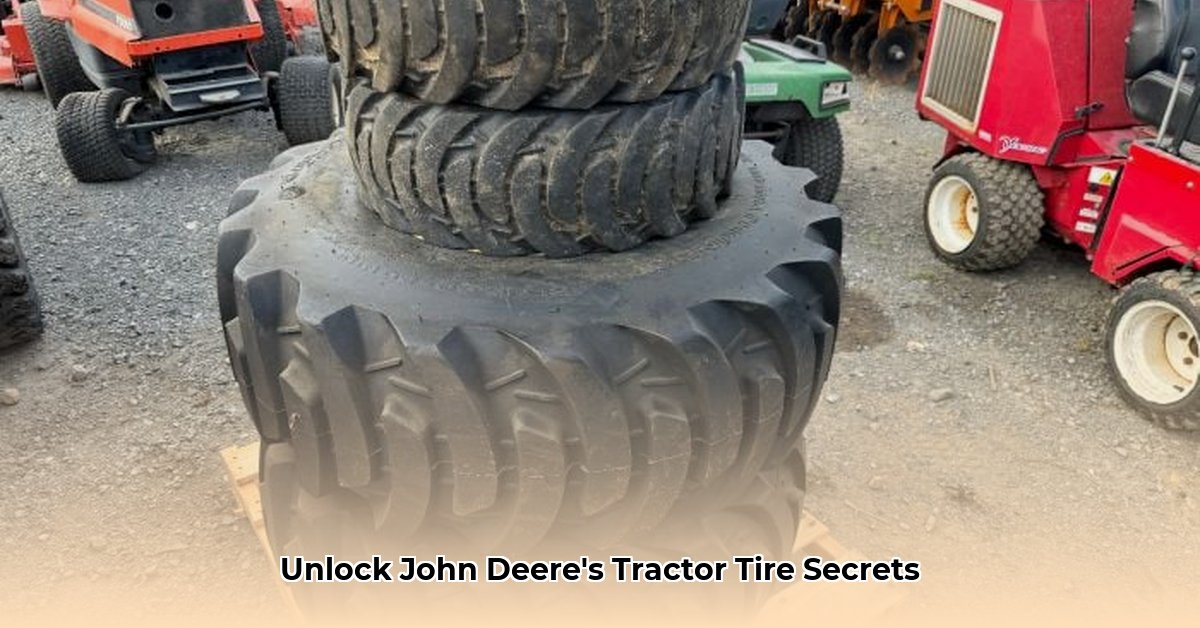
Choosing the right tires for your John Deere tractor is crucial for optimizing fuel efficiency, maximizing crop yields, promoting soil health, and extending the lifespan of your equipment. This comprehensive guide will help you navigate the complexities of tire selection, installation, maintenance, and sustainable practices. We'll compare John Deere tires with aftermarket options, providing you with the actionable intelligence you need to make informed decisions. For more information on specific tire sizes, see our guide on 8-16 R1 tractor tires.
Understanding Your Farming Operation: A Personalized Approach
Before diving into tire specifications, consider your unique farming style. What types of terrain do you typically work? Do you primarily operate in fields or navigate rougher landscapes? How heavy are your typical loads? Understanding your workload helps determine the most critical tire features – be it optimal grip, extended lifespan, or fuel efficiency. What are your top priorities: maximizing traction, minimizing soil compaction, or achieving the longest possible tire life?
Decoding Tractor Tire Types: R1s, IFs, VFs, and More
The variety of John Deere tractor tires can be overwhelming. Let's clarify the most common types:
R-1 Tires: These general-purpose tires offer a balance of traction and longevity, suitable for everyday fieldwork. They are a reliable choice for many farmers.
R-1W Tires: Designed for superior grip in wet conditions, these tires feature a wider tread pattern for improved traction in muddy or saturated environments.
IF (Improved Flexion) Tires: These tires handle heavier loads at lower inflation pressures, resulting in less soil compaction and improved land health.
VF (Very High Flexion) Tires: Offering even greater load capacity and reduced soil compaction than IF tires, these are ideal for heavy-duty applications. While more expensive upfront, long-term cost savings may offset the initial investment.
Choosing the Right John Deere Tractor Tires: A Step-by-Step Guide
Selecting the perfect tires is like choosing the right tool for a specific job. Follow these steps to ensure a proper fit:
Consult Your Tractor's Manual: The owner's manual specifies recommended tire sizes and load capacities. Ignoring these guidelines can lead to equipment damage.
Assess Terrain and Workload: Consider soil type (sandy, clay, etc.), typical load weights, and prevailing weather conditions (wet or dry). These factors heavily influence tire selection.
Establish a Budget: Tire prices vary significantly. Balance performance requirements with budgetary constraints. While premium tires have a higher upfront cost, their longer lifespan might deliver long-term savings.
OEM vs. Aftermarket Tires: John Deere OEM (Original Equipment Manufacturer) tires provide a guaranteed fit and often include comprehensive warranties. However, aftermarket tires can offer significant cost savings, though quality may vary. Thoroughly research aftermarket options, comparing specifications and reading reviews before making a purchase.
Maintaining Your Tires for Peak Performance: A Proactive Approach
Proper tire maintenance is essential for maximizing lifespan and performance. Here are some key practices:
Regular Air Pressure Checks: Both underinflation and overinflation lead to premature tire wear and decreased fuel efficiency. Maintain the recommended air pressure as indicated on the tire sidewall or in your owner's manual.
Frequent Inspections: Regularly inspect tires for cuts, punctures, or uneven wear. Addressing minor issues promptly prevents more extensive (and costly) repairs.
Tire Rotation: Rotate tires periodically to promote even wear and extend their useful life. Follow the rotation schedule recommended by the tire manufacturer or your tractor's manual.
Proper Storage: When not in use, store tires in a cool, dry place, away from direct sunlight and extreme temperatures. This helps prevent deterioration and damage.
Sustainability in Tire Selection: Farming Responsibly
Sustainable agricultural practices are paramount. Choosing durable, long-lasting tires minimizes waste and reduces your environmental footprint. Consider tire recycling programs when replacing worn tires. Utilizing lower inflation pressures (as mentioned earlier) reduces soil compaction, preserving soil health and fertility. Additionally, choosing tires made with sustainable materials can further minimize your farm's environmental impact.
OEM vs. Aftermarket Tires: A Comparative Overview
The following table summarizes the key differences between OEM and aftermarket tires:
| Feature | OEM (John Deere) | Aftermarket |
|---|---|---|
| Price | Generally Higher | Generally Lower |
| Warranty | Comprehensive Manufacturer's Warranty | Varies; requires careful examination |
| Availability | Readily available through John Deere dealers | Availability may vary; potential delays |
| Quality | Meets John Deere standards | Quality varies; thorough research crucial |
The optimal choice depends on individual priorities and budget. Weigh the pros and cons, considering the total cost of ownership over the tire's lifespan. Consult experienced farmers or John Deere specialists for personalized advice.
Key Takeaways:
- Tire selection significantly impacts tractor performance and farming practices.
- The ideal tire choice depends on specific needs and priorities (e.g., lawn care vs. heavy-duty tasks).
- A thorough comparison is needed between OEM (John Deere) tires and aftermarket alternatives.
- Proper tire maintenance enhances longevity and minimizes environmental impact.
- Careful consideration of sustainable practices strengthens long-term farming efficiency and environmental stewardship.